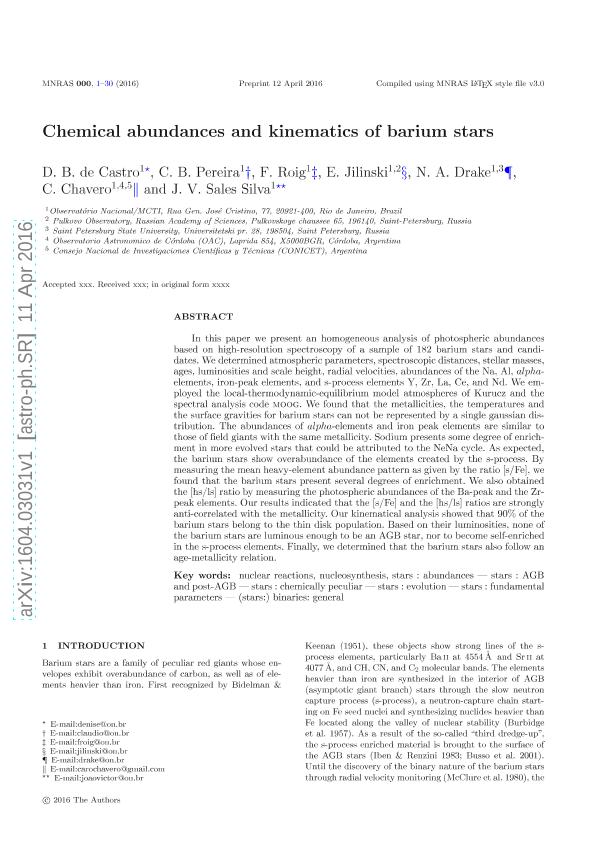Mostrar el registro sencillo del ítem
dc.contributor.author
de Castro, D.B.
dc.contributor.author
Pereira, C. B.
dc.contributor.author
Roig, F.
dc.contributor.author
Jilinski, E.
dc.contributor.author
Drake, N. A.
dc.contributor.author
Chavero, Carolina Andrea

dc.contributor.author
Sales Silva, J. V.
dc.date.available
2022-11-30T16:05:33Z
dc.date.issued
2016-03
dc.identifier.citation
de Castro, D.B.; Pereira, C. B.; Roig, F.; Jilinski, E.; Drake, N. A.; et al.; Chemical abundances and kinematics of barium stars; Oxford University Press; Monthly Notices of the Royal Astronomical Society; 459; 4; 3-2016; 4299-4324
dc.identifier.issn
0035-8711
dc.identifier.uri
http://hdl.handle.net/11336/179569
dc.description.abstract
In this paper, we present an homogeneous analysis of photospheric abundances based on high-resolution spectroscopy of a sample of 182 barium stars and candidates. We determined atmospheric parameters, spectroscopic distances, stellar masses, ages, luminosities and scaleheight, radial velocities, abundances of the Na, Al, α-elements, iron-peak elements, and s-process elements Y, Zr, La, Ce, and Nd. We employed the local thermodynamic equilibrium model atmospheres of Kurucz and the spectral analysis code moog. We found that the metallicities, the temperatures and the surface gravities for barium stars cannot be represented by a single Gaussian distribution. The abundances of α-elements and iron peak elements are similar to those of field giants with the same metallicity. Sodium presents some degree of enrichment in more evolved stars that could be attributed to the NeNa cycle. As expected, the barium stars show overabundance of the elements created by the s-process. By measuring the mean heavy-element abundance pattern as given by the ratio [s/Fe], we found that the barium stars present several degrees of enrichment. We also obtained the [hs/ls] ratio by measuring the photospheric abundances of the Ba-peak and the Zr-peak elements. Our results indicated that the [s/Fe] and the [hs/ls] ratios are strongly anticorrelated with the metallicity. Our kinematical analysis showed that 90 per cent of the barium stars belong to the thin disc population. Based on their luminosities, none of the barium stars are luminous enough to be an asymptotic giant branch star, nor to become self-enriched in the s-process elements. Finally, we determined that the barium stars also follow an age-metallicity relation.
dc.format
application/pdf
dc.language.iso
eng
dc.publisher
Oxford University Press

dc.rights
info:eu-repo/semantics/openAccess
dc.rights.uri
https://creativecommons.org/licenses/by-nc-sa/2.5/ar/
dc.subject
ABUNDANCES
dc.subject
BINARIES: GENERAL
dc.subject
NUCLEAR REACTIONS
dc.subject
NUCLEOSYNTHESIS
dc.subject
STARS: ABUNDANCES
dc.subject
STARS: AGB AND POST-AGB
dc.subject
STARS: CHEMICALLY PECULIAR
dc.subject
STARS: EVOLUTION
dc.subject
STARS: FUNDAMENTAL PARAMETERS
dc.subject.classification
Astronomía

dc.subject.classification
Ciencias Físicas

dc.subject.classification
CIENCIAS NATURALES Y EXACTAS

dc.title
Chemical abundances and kinematics of barium stars
dc.type
info:eu-repo/semantics/article
dc.type
info:ar-repo/semantics/artículo
dc.type
info:eu-repo/semantics/publishedVersion
dc.date.updated
2022-11-30T12:08:16Z
dc.journal.volume
459
dc.journal.number
4
dc.journal.pagination
4299-4324
dc.journal.pais
Reino Unido

dc.journal.ciudad
Londres
dc.description.fil
Fil: de Castro, D.B.. Ministério de Ciencia, Tecnologia e Innovacao. Observatorio Nacional; Brasil
dc.description.fil
Fil: Pereira, C. B.. Ministério de Ciencia, Tecnologia e Innovacao. Observatorio Nacional; Brasil
dc.description.fil
Fil: Roig, F.. Ministério de Ciencia, Tecnologia e Innovacao. Observatorio Nacional; Brasil
dc.description.fil
Fil: Jilinski, E.. Ministério de Ciencia, Tecnologia e Innovacao. Observatorio Nacional; Brasil
dc.description.fil
Fil: Drake, N. A.. Ministério de Ciencia, Tecnologia e Innovacao. Observatorio Nacional; Brasil
dc.description.fil
Fil: Chavero, Carolina Andrea. Universidad Nacional de Córdoba. Observatorio Astronómico de Córdoba; Argentina. Consejo Nacional de Investigaciones Científicas y Técnicas. Centro Científico Tecnológico Conicet - Córdoba; Argentina
dc.description.fil
Fil: Sales Silva, J. V.. Ministério de Ciencia, Tecnologia e Innovacao. Observatorio Nacional; Brasil
dc.journal.title
Monthly Notices of the Royal Astronomical Society

dc.relation.alternativeid
info:eu-repo/semantics/altIdentifier/doi/http://dx.doi.org/10.1093/mnras/stw815
Archivos asociados
